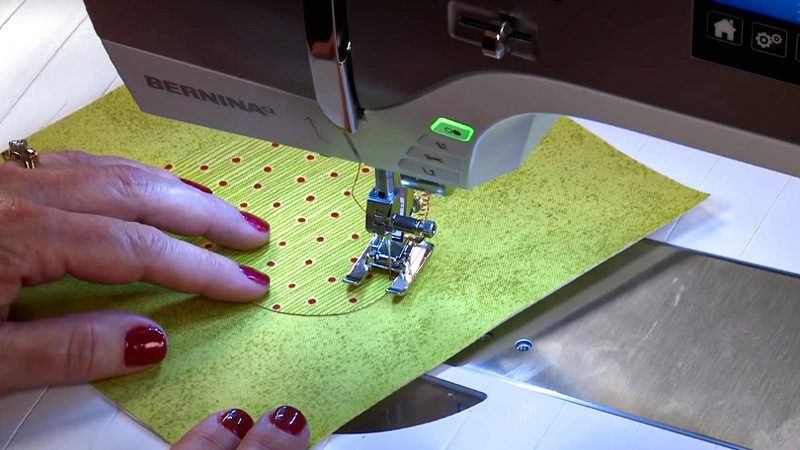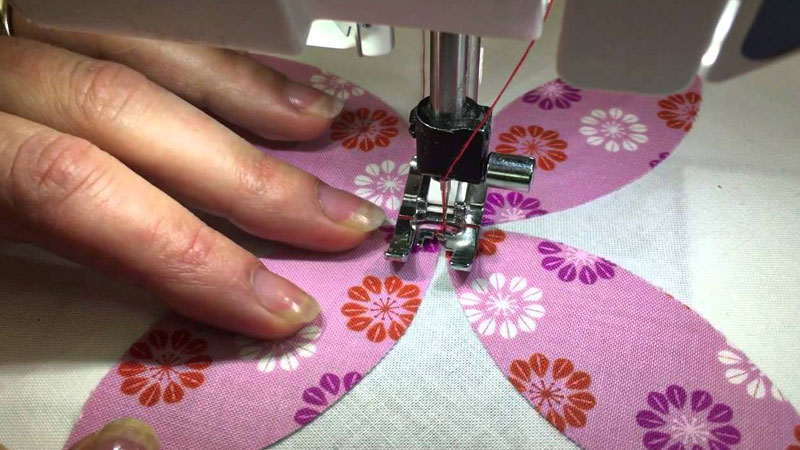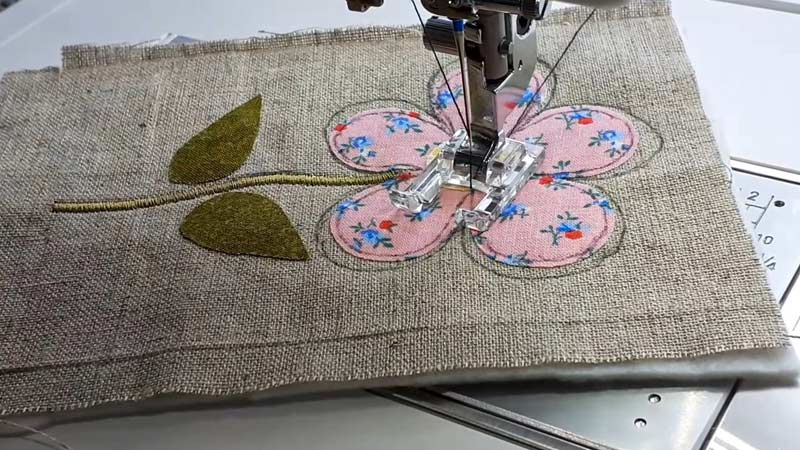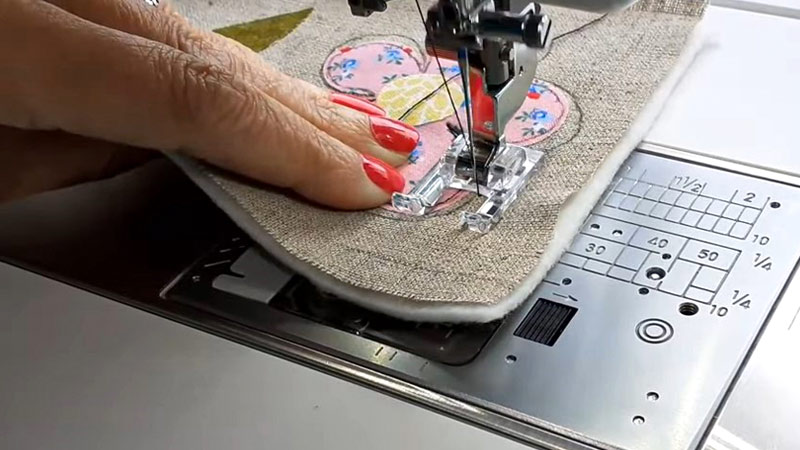Appliqué stands as a cherished technique in the realm of crafting, revered for its versatility and creative potential.
Through the artful attachment of smaller fabric pieces onto a larger base, appliqué brings forth a world of personalized designs and intricate detailing.
This technique transcends the boundaries of sewing, finding its place in quilting, visual arts, and a myriad of creative endeavors.
From clothing embellishments to home decor accents, appliqué breathes life into projects, offering a unique avenue for self-expression.
Its accessibility and resourcefulness, coupled with the ability to blend with various mediums, make appliqué a cherished skill, enriching the world of textile arts.

What Does Applique Mean in Sewing?
In sewing, “appliqué” refers to the technique of attaching smaller pieces of fabric onto a larger base material to create decorative designs or patterns.
This is achieved by stitching the edges of the smaller fabric pieces onto the larger fabric using various types of stitches, such as a satin stitch or a blanket stitch.
Appliqué allows for a wide range of creative expression, enabling crafters to add unique and personalized elements to their projects.
It is a versatile technique used in a variety of sewing projects, from clothing and accessories to quilts and home decor.
Appliqué is valued for its ability to introduce texture, dimension, and intricate detailing, making it a popular choice for both functional and artistic applications in the world of sewing and crafting.
Why Is Applique a Good Technique?

Appliqué is a versatile and popular technique in various crafts, including sewing, quilting, and even in some forms of visual arts.
There are several compelling reasons why appliqué is considered a valuable and beneficial technique:
Versatility
Appliqué can be applied to a wide range of projects, from clothing and accessories to home decor items like quilts, pillow covers, and wall hangings. Its adaptability makes it a valuable skill for both beginner and experienced crafters.
Personalization and Customization
It allows for a high degree of personalization and customization. Crafters can use appliqué to add their own unique designs, patterns, and imagery to their projects, making them one-of-a-kind creations.
Utilizes Fabric Scraps
Appliqué is an excellent way to make use of fabric scraps and remnants.
By cutting small pieces of fabric and attaching them to a base material, crafters can transform leftover materials into beautiful and functional items.
Texture and Dimension
Appliqué adds texture and dimension to a project, creating a visual interest that might be challenging to achieve through other techniques.
This is particularly beneficial for creating eye-catching designs on clothing and accessories.
No Specialized Equipment Required
Unlike some other advanced sewing or crafting techniques that may require specialized tools or machinery, appliqué can be accomplished with basic sewing supplies like needles, thread, and scissors. This makes it accessible to a wide range of crafters.
Layering and Mixed Media
Appliqué can be combined with other techniques such as embroidery, beading, or painting to create intricate and visually striking designs.
This allows for a blending of different artistic mediums, resulting in unique and compelling artwork.
Repairs and Upcycling
Appliqué can be used to repair damaged clothing or items with holes or tears.
By applying an appliqué patch, crafters can extend the life of their belongings and give them a fresh, customized look.
Cultural and Artistic Traditions
Appliqué has a rich history in many cultures around the world. Learning and incorporating appliqué techniques can be a way to connect with and honor these traditions, adding depth and cultural significance to your creations.
Teaches Precision and Patience
Working on appliqué projects requires attention to detail and patience. It involves careful cutting, positioning, and stitching.
These skills can be valuable for developing fine motor skills and cultivating a sense of craftsmanship.
Therapeutic and Relaxing
Engaging in appliqué can be a meditative and calming activity. The repetitive nature of stitching and the focus required can provide a sense of mindfulness, reducing stress and promoting mental well-being.
Types of Applique
There are several types of appliqué techniques, each offering unique styles and methods of attaching fabric to a base material.
Here are some of the most common types:
Raw Edge Appliqué

In raw edge appliqué, the edges of the appliqué fabric are intentionally left unfinished, giving a frayed or textured look.
It’s a relaxed and casual style often used for projects with a rustic or vintage aesthetic.
Turned Edge Appliqué
This method involves folding under the edges of the appliqué fabric before stitching it onto the base material.
It creates a clean, polished look suitable for more formal or refined projects.
Needle-Turn Appliqué
Needle-turn appliqué is a hand-sewing technique where the edges of the appliqué fabric are turned under using a needle and thread, creating a seamless and precise finish.
Fusible Appliqué
Fusible webbing is used to adhere the appliqué fabric to the base material. This method involves ironing the fabric pieces in place, providing a quick and easy way to secure appliqués.
Broderie Perse
This technique involves cutting motifs or patterns from printed fabric and appliquéing them onto a contrasting background, often used in quilting to create intricate designs.
Machine Appliqué
As the name suggests, machine appliqué involves using a sewing machine to attach the appliqué fabric to the base material.
This method is faster and more suitable for projects with a large number of appliqués.
What Are Some Examples of Applique Projects?

Appliqué can be applied to a wide range of projects across various crafts.
Here are some examples of appliqué projects:
Quilts
Appliqué in quilting allows for the creation of stunning focal points within quilt blocks.
This technique is often used to depict intricate floral arrangements, whimsical animals, or even complex geometric patterns.
It adds depth and visual interest to quilts, making them unique and visually appealing.
Clothing and Accessories
In the realm of clothing, appliqué can transform basic garments into personalized and stylish pieces.
For instance, a plain denim jacket can become a statement piece with the addition of appliqué patches depicting vibrant flowers or abstract designs.
Appliqué is also used to adorn accessories like hats, giving them a distinctive and custom look.
Home Decor Items
Appliqué can breathe life into various home decor items. Pillow covers, for example, can be adorned with appliqué designs that match the theme of a room.
Table runners with appliqué motifs can add a touch of elegance to dining spaces, while curtains can be embellished with appliqué patterns for a unique and custom window treatment.
Baby Blankets and Onesies
Appliqué is a delightful choice for baby items. Soft, cuddly blankets can be personalized with appliqué designs representing cute animals, letters, or even the baby’s name.
Onesies can be adorned with playful appliqué shapes or characters, creating charming and memorable outfits for infants.
Tote Bags and Purses
Appliqué transforms ordinary bags into unique, eye-catching accessories. Tote bags and purses can be customized with appliqué designs that reflect the owner’s personality or interests.
This not only adds flair to the bag but also makes it a statement piece that stands out.
Aprons and Kitchen Linens
Appliqué in kitchen linens adds a touch of whimsy and personality to the heart of the home. Aprons can be adorned with delightful appliqué motifs, such as fruits, utensils, or charming critters.
Dish towels and pot holders can be embellished with colorful designs, making kitchen tasks more enjoyable.
Holiday Decorations
Appliqué brings festive cheer to holiday decorations. Christmas tree skirts can be adorned with intricate appliqué scenes, while stockings can be personalized with appliqué initials or playful holiday motifs.
Decorative table runners featuring appliqué designs set the stage for memorable holiday gatherings.
Cushion Covers
Appliqué transforms ordinary cushion covers into focal points of a room.
Whether it’s a single large appliqué design or a collection of smaller ones, these covers add a pop of color and pattern to sofas and chairs, tying together the overall decor scheme of a space.
Children’s Clothing
Appliqué adds a playful and personalized touch to children’s clothing.
T-shirts, dresses, and pajamas can feature appliqué designs depicting favorite animals, characters, or playful shapes. These garments become cherished pieces that reflect a child’s unique personality.
Tips for Successful Applique

To achieve successful appliqué results, it’s important to pay attention to details and follow certain techniques.
Here are some valuable tips for successful application:
Choose the Right Fabric
Select a fabric that is appropriate for your project and application method. Cotton fabrics work well for most appliqué projects because they are easy to work with and come in a wide variety of colors and patterns.
Stabilize the Base Fabric
If you’re working on a project that involves lightweight or stretchy fabric, use stabilizers like fusible interfacing or tear-away stabilizers to provide support and prevent distortion.
Prepare Your Appliqué Pieces
Cut your appliqué shapes precisely using sharp fabric scissors or rotary cutters. Ensure that the edges are clean and even, especially if you’re going for a turned-edge or needle-turn appliqué.
Consider Seam Allowance
Determine the seam allowance you want to use for attaching the appliqué pieces, and be consistent throughout your project. Common seam allowances are 1/8 inch, 1/4 inch, or 3/8 inch.
Secure Appliqué Pieces
Depending on your chosen appliqué method (fusible, raw edge, or turned edge), secure the appliqué pieces to the base fabric using pins, clips, or temporary fabric adhesive before stitching.
Choose Appropriate Thread
Select thread that matches the color of your appliqué pieces or the background fabric. The thread should also be appropriate for the stitching method you plan to use.
Practice Stitching Techniques
Familiarize yourself with different stitching techniques such as satin stitch, blanket stitch, or straight stitch, depending on the desired effect. Practice on scrap fabric to improve your stitching skills.
Thread Tension and Needle Choice
Adjust your sewing machine’s thread tension as needed to prevent puckering or looping. Choose the appropriate needle type and size for your fabric and thread.
Start with Simple Designs
If you’re new to appliqué, begin with simple shapes and designs. As you gain confidence, you can gradually work on more intricate projects.
Use Templates
Consider using templates or stencils to ensure consistent shapes and sizes for your appliqué pieces. Templates can also help with positioning and alignment.
Secure Appliqué Edges
If you’re using raw edge appliqué, consider using a fray-check or fabric glue along the edges to prevent fraying over time.
FAQs
What is appliqué and how is it used in crafting?
Appliqué is a technique where smaller pieces of fabric are attached onto a larger base material to create decorative designs or patterns.
What makes appliqué a versatile technique?
Appliqué is versatile because it can be applied to a wide range of projects, from clothing and accessories to home decor items like quilts and pillow covers.
How does appliqué allow for personalization and customization?
Appliqué enables crafters to add their own unique designs, patterns, and imagery to their projects, making each piece one-of-a-kind.
What are the benefits of using appliqué for upcycling and repairs?
Appliqué can be used to repair damaged clothing or items with holes or tears. By applying an appliqué patch, crafters can extend the life of their belongings and give them a fresh, customized look, contributing to sustainable and eco-friendly practices.
Is specialized equipment required for practicing appliqué?
No, unlike some advanced sewing or crafting techniques, appliqué can be accomplished with basic sewing supplies like needles, thread, and scissors.
To Wrap Up
Appliqué remains an enduring and cherished technique, celebrated for its ability to transform ordinary materials into extraordinary works of art.
Its adaptability transcends the confines of fabric, weaving threads of creativity into various realms, from sewing to quilting, and beyond.
Appliqué empowers crafters to infuse their unique identities into their creations, breathing life into fabrics, and instilling them with personality and character.
Its resourcefulness, accessible nature, and capacity to blend with diverse artistic mediums make it a true gem in the world of crafting.
With every carefully applied stitch, appliqué allows us to celebrate tradition, embrace innovation, and weave the threads of our creativity into the fabric of our lives.
Leave a Reply